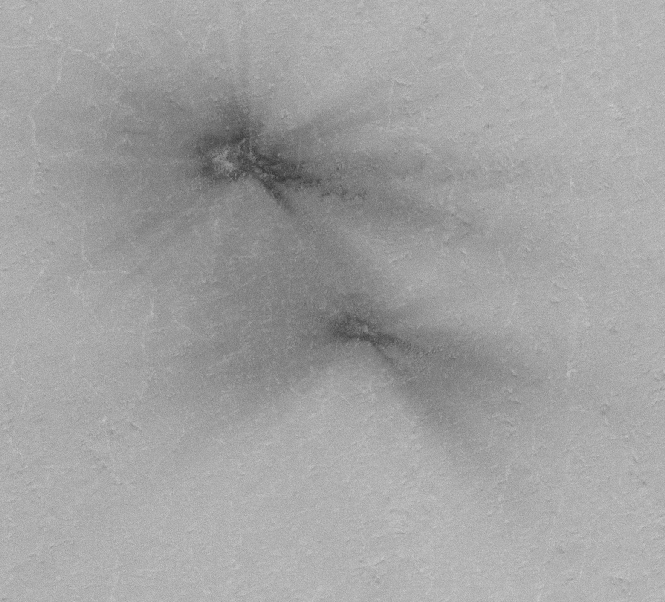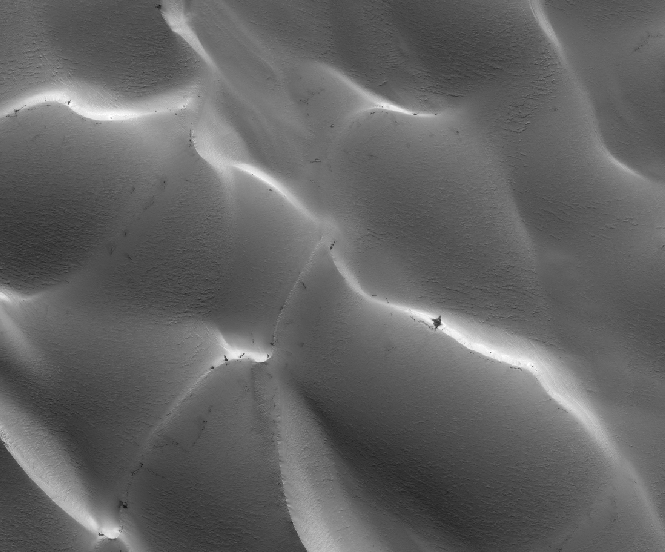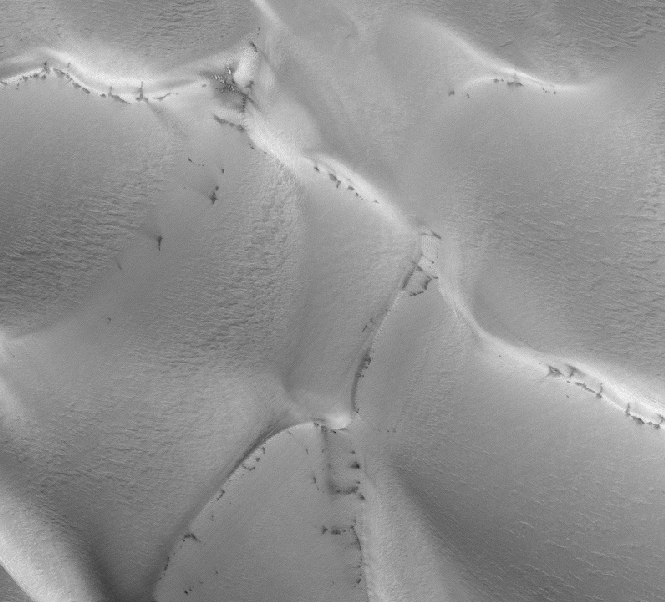No spiders in the North, but an octopus or two?
-
 by
wassock
moderator
by
wassock
moderator
Bringing this out front the team talk thread:
I noted that Candy said that there are no spiders in the North, which sounded like a challenge so......HiRise has lots of images labelled as possible spider or araneiform sites but this seems to be because there are fans in them such as this one -
But look closer and the fans here look different they are narrower and to my mind more comet/meteor like in appearance, a dark dense head and thinning tail.
The next one has a whole bunch of multi directional fans but again they appear different to the southern fans. Any takers for there being a difference before we start to wonder why?
And as Candy says no sign of any spiders
Posted
-
 by
wassock
moderator
by
wassock
moderator
Actually there are more Octopi than spiders here. This imgae is taken from the HiRise showing the multidirectional fans.
Most of them share the same "squid like" morphology seen in the Octopus shown here. But whilst we have no spiders there are some polygonal cracks visible. It may be wishful thinking but the cracks look to me as if they are concentric to the central fan?
Posted
-
 by
Kitharode
moderator
by
Kitharode
moderator
Squid-like octopi and concentric polygonal cracks. I see now why you posted this in Chat and not Science. There's gotta be a joke in there somewhere. 😮
I've got to agree that the polygons give a strong impression of being concentric to the squids, but obviously more samples required.
I get the impression (more apparent in the smaller of the two squids above) of a bi-polar wind. A multi directional fan halo around the body and another around the legs. It may be that the wind direction goes all the way round clockwise or counter clockwise, but I rather like the idea of a bi-polar wind. (Probably a joke in there too) 😉
Do we know if the squids are permanent or transient?
Posted
-
 by
wassock
moderator
by
wassock
moderator
The image with the multidirection fans in the first post has an area of what look like dunes in the bottom half on the left side.
This detail shows a close up of part of that area in 2008

And again in 2010

So if these are dunes they don't move about much - same thing for the 'ripples' at the top of the main image
Posted
-
 by
Kitharode
moderator
by
Kitharode
moderator
You make a good point. So if not dunes, what might they be?
There are (I believe) polar layered deposits at both poles. Looking again at the Hirise image (second link in first post) could we be looking at an area of 'exposed edges' of these layers?
Can you give us Latitude and Longitude for the image to see if that helps?
Posted
-
 by
wassock
moderator
by
wassock
moderator
Index page for the 2010 image is here http://hirise.lpl.arizona.edu/ESP_016095_2655
Posted
-
 by
Kitharode
moderator
by
Kitharode
moderator
Cheers. So we're centred at latitude 85 degrees. This puts us about 350km from the north pole. The latitude 85 circle has a diameter of about 700km. The residual ice cap has a diameter of roughly 1000km. This would suggest that the area is on the ice cap itself.
However, the outer edge of the ice cap is highly convoluted and it is quite possible that the area lies just outside the edge. This would put it into a recognised 'low albedo feature' that surrounds the north pole, an area of wind-blown dunes.
Hardly scientific, but hopefully interesting if not useful. 😛
Icecover and albedo feature here: http://www.edb.utexas.edu/missiontomars/images/mars-hst3.jpeg
Posted
-
 by
wassock
moderator
by
wassock
moderator
Can we have "previously wind blown dunes that are now frozen solid"?
Posted
-
 by
Kitharode
moderator
by
Kitharode
moderator
I'm sure we can. Didn't we hear about this when you posted the 'slugs' image? (Where was that? One of PJ's old threads?)
Posted
-
 by
wassock
moderator
by
wassock
moderator
I thought the slugs were moving will go looksee
Posted
-
 by
mschwamb
scientist, translator
in response to wassock's comment.
by
mschwamb
scientist, translator
in response to wassock's comment.
I'm not a planetary surfaces expert so my knowledge of dunes is pretty basic. These might be Barchan dunes. Just wanted to comment since I missed this the first time I looked at this thread. I am pretty sure we wouldn't expect dunes to move or change significantly over such short time spans at least for Mars and Titan.
are dunes in the North and the image you have loots similar.
Cheers,
~Meg
Posted
-
 by
Kitharode
moderator
by
Kitharode
moderator
Meg: Thanks a lot. If your knowledge is "pretty basic" then mine is less than rudimentary. Now, in many ways wind-blown dune formation, shape, and migration are easy to visualise be that on Earth or Mars. What's more difficult to visualise is the 'core' of a dune. My instinct is to assume that the core of a dune on Mars will be different than a dune on Earth. I'm thinking lower temperatures, less gravity so different rate of compaction (pressure?), more ice content, etc. Or am I off target here?
Wassock: The 'slugs' might move, but if memory serves they are shaped by wind blowing down their length (from one end to the other) rather than wind blowing 'across their sides'. My impression was that the central core of the slug became somewhat solidified making it more of a stationary object (ish).
I'm having a looksee myself - No luck yet. C'mon sluggy sluggy....Here sluggy sluggy.......
Posted
-
 by
mschwamb
scientist, translator
in response to Kitharode's comment.
by
mschwamb
scientist, translator
in response to Kitharode's comment.
I think the difference between Earth, Mars, Titan, might be scale in terms of size. What makes up the dunes is sand grains. They may be different in size due to the different gravity and wind speed. I found this, which might give some more context about positions and properties of Dunes on Mars.
Cheers,
~Meg
Posted
-
 by
Kitharode
moderator
by
Kitharode
moderator
Great link. What a fantastic website. Thanks Meg. I never knew dunes could be so interesting - I'm hooked already. ** 😛 **
Posted